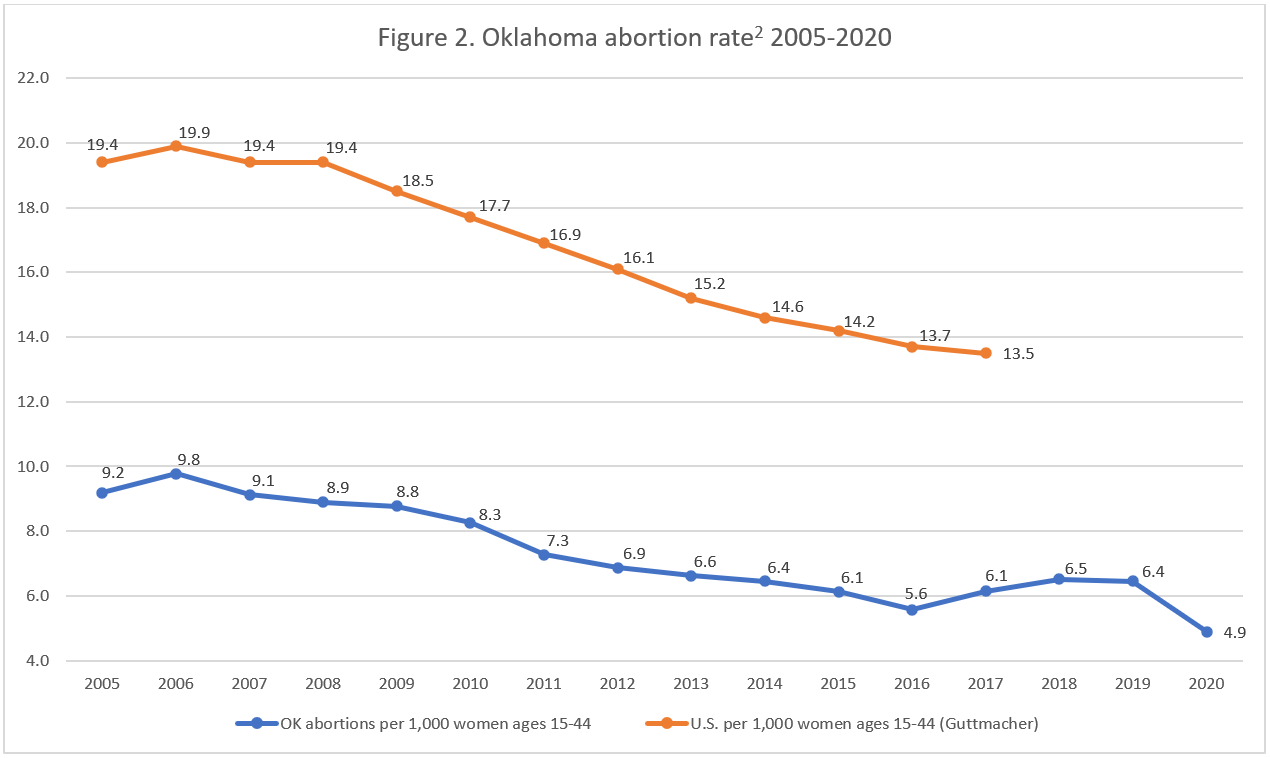Abortion Reporting: Oklahoma (2020)
The Charlotte Lozier Institute’s summary of Oklahoma’s 2021 abortion report is forthcoming.
Oklahoma’s 2020 abortion report was published by the Oklahoma State Department of Health (OSDH) in June 2021. The report shows that abortions declined from the previous year.
Changes in Oklahoma Abortions, 2019-2020

The report does not include information on Planned Parenthood’s Oklahoma abortion market share.
Abortion Totals and Trends
There were 3,797 abortions reported in Oklahoma in 2020, a 24 percent drop from the previous year (Fig. 1). Chemical abortions declined by less than two percent, making up 65 percent of the total in 2020, up from 50 percent in 2019. The Charlotte Lozier Institute (CLI) estimates that Oklahoma’s abortion rate declined by 24 percent to just 4.9 abortions per 1,000 women ages 15 to 44 (Fig. 2). Of the 11 states that reported 2020 abortion totals by June 2021, three reported that abortions declined from the previous year.
State Report Summary
Demographic Information
In 2020, 83 percent of Oklahoma abortions were performed on state residents, compared to 89 percent the year before. Fifteen percent were on women from other states, including nine percent on Texas women, four percent on women from Arkansas, one percent on Missouri women, and not quite one percent on Kansas women. Residency was not reported for two percent of the abortions.
Ten percent of the abortions reported in Oklahoma were performed on girls under the age of 20. Thirty-two percent were obtained by women ages 20 to 24, and 28 percent were performed on women ages 25 to 29, while 18 percent were on women ages 30 to 34. Twelve percent of the abortions were performed on women ages 35 and older.
Just over half of Oklahoma abortions, 51 percent, were performed on white women. Twenty-one percent were performed on black women, and four percent each were on American Indian or Alaska Native women and Asian or Pacific Islander women. Nineteen percent of the abortions were performed on women of other unspecified races.
Ten percent of the abortions were on women who had not finished high school, and 37 percent were performed on women with a high school diploma or its equivalent. Thirty-nine percent were on women who had attended college, and 14 percent were on women who had a college degree. The vast majority (81 percent) were obtained by unmarried women, and a little over 18 percent were married.
Seventy-two percent of Oklahoma abortions were on women with at least one previous pregnancy. Twenty-four percent of the women undergoing abortions had one previous live birth, and 36 percent had two or more prior births, while 39 percent had no previous live births. Twenty-one percent of the abortions were performed on women with one prior abortion, and 10 percent were on women with more than one, compared to 69 percent on women with no prior abortions. Nineteen percent of the abortions were on women who had previously had a miscarriage.
Oklahoma allows women undergoing abortions in the state to share their reasons for choosing to do so. Each woman may give multiple reasons. In 2020, the majority of the reasons had to do with relationship or socioeconomic concerns. Twenty-two forms checked the box that the abortion met the definition of a medical emergency according to Section 1-738.1A of Oklahoma Statutes, and five checked the box that the abortion met the definition of a medical emergency according to Section 1-745.2. Both these sections define a medical emergency as an immediate physical risk to the woman’s life or a major bodily function. Additionally, 35 forms checked the box that the abortion was necessary to save the mother’s life, a much higher number than the previous year; the report did not indicate whether the risk was immediate. Thirteen abortions were performed due to rape, while the number of abortions for incest was suppressed, as Oklahoma suppresses small numbers, or numbers that could be used to estimate small numbers, to protect privacy.
Medical Information
In 2020, 65 percent of Oklahoma abortions were chemical, a record high. A quarter were suction aspiration procedures, and four percent were performed via dilation and evacuation. Another four percent were performed using dilation and curettage, and two percent were performed using other or unknown methods. For 48 percent of the chemical abortions, the doctor was in the room when the woman was first administered the pills.
Almost three-quarters of the abortions reported in Oklahoma (74 percent) occurred at eight weeks of gestation or earlier. Fourteen percent were performed between nine and 10 weeks, and six percent were reported between 11 and 12 weeks of gestation. Three percent occurred between 13 and 15 weeks and two percent between 16 and 20 weeks. Twelve abortions (0.3 percent) were performed at 21 weeks of gestation. Oklahoma limits abortion at 20 weeks post-fertilization (around 22 weeks of gestation). Except in medical emergencies, doctors are required to determine probable post-fertilization age or rely on a determination from another physician. In 2020, probable post-fertilization age was determined in advance of 73 percent of the abortions. Probable post-fertilization age was not determined for one percent of the abortions and was reported as not applicable for 25 percent. The report did not indicate why post-fertilization age was not applicable in these cases.
Forty-eight percent of the abortions were performed by OB/GYNs, and 26 percent were performed by general practice physicians. The physician’s specialty was not reported for another 26 percent of the abortions, and the number of doctors with hospital privileges was suppressed. Thirty-one percent of the women undergoing abortions received anesthesia, and 10 of the unborn babies being aborted were provided with anesthesia. The report does not indicate whether these babies were given anesthesia because they were old enough to feel pain.
Ultrasounds were performed in advance of almost all Oklahoma abortions (99.6 percent), with 54 percent conducted vaginally, 45 percent abdominally, and 0.4 percent using both methods. Over half of the ultrasounds (54 percent) were performed by the doctor performing the abortion, while two percent were conducted by a different doctor and 44 percent by someone else. Oklahoma law requires that if a pregnancy is at least eight weeks post-fertilization, the woman must be offered the opportunity to listen to her baby’s heartbeat. In 2020, 73 percent of the women undergoing abortions were asked if they would like to hear the heartbeat, and 19 percent had the heartbeat made audible for them to hear.
Twenty-seven percent of the unborn babies’ bodies were disposed of at home. Sixteen percent were discarded as medical waste, and 15 percent were incinerated. The method of disposition was unknown or not reported for 41 percent of the abortions. Overall, abortions in which disposition was unreported or took place at home accounted for 68 percent of the total, close to the percent of abortions that were chemical. The numbers of male and female babies killed by abortion were suppressed in accordance with Oklahoma’s data suppression guidelines.
Although the exact number of complications was suppressed, there were six failed abortions with ongoing pregnancies and six cases of heavy bleeding or hemorrhage. There were 12 other unspecified complications.1 No women were reported to have died as a result of abortion, and no babies were reported to have been born alive during abortions.
Legal and Financial Information
Except in medical emergencies, Oklahoma requires that before an abortion is performed, the woman must be provided with the medical facts about the abortion and information about her alternatives. In 2020, over 99 percent of the women received the informed consent information, and 31 percent chose to have additional information mailed to them. There were some exceptions due to medical emergencies, but the exact number was suppressed. Oklahoma further requires that before abortions at 20 weeks of gestation or later, additional information must be provided to the woman considering abortion; in 2020, there were 18 abortions reported after 20 weeks, all of which fell under the medical emergency exception to this requirement.
Oklahoma prohibits public employees, agencies, or facilities from performing abortions except in cases of rape, incest, and risk to the mother’s life. In the past few reports, fewer than five such abortions were reported each year. However, in 2020, 996 abortions were performed in the scope of a state employee’s employment or by a public agency, 26 percent of all abortions reported in Oklahoma. Of these, no abortions for rape or incest were reported, while the number of abortions to save the mother’s life was suppressed due to being fewer than five. CLI asked the Oklahoma Department of Health for an explanation, and the department contacted the compliance officers of the abortion centers that had reported the 996 abortions in this category. The abortion centers confirmed that these abortions had been incorrectly reported and had not actually taken place in the scope of a public employee’s employment. As a result, the health department noted that the abortion centers have committed to instituting additional training to ensure that similar misreporting does not occur going forward.
Before an abortion may be performed on a minor in Oklahoma, parental consent must be obtained. In 2020, there were no judicial waivers to the parental consent requirement. In 2020, the parents of 143 minors seeking abortions were notified. The number of minors who did not go on to get an abortion, if any, was suppressed. The number of cases in which a minor’s parents were not notified in advance of the abortion was also suppressed.
Over 99 percent of Oklahoma abortions were private pay. There were seven abortions covered by private insurance and five funded by Medicaid. Oklahoma Medicaid covers abortion only in cases of risk to the mother’s life or rape or incest. Over half the abortions (51 percent) cost between $601 and $700. Twenty-eight percent cost less, with one percent costing less than $500 and 27 percent $501 to $600. Twenty-one percent cost more, with 16 percent between $701 and $800 and five percent over $800.
In 2020, the month of January had the most abortions (501), and December had the fewest (168).
Abortion During the Pandemic
Oklahoma is in the minority of states that reported decreases in abortion in 2020. One possible cause is the postponement of elective abortions due to the pandemic, with the number of abortions performed in March 2020 being 59 percent lower than the March 2019 total. On March 27, 2020, the governor of Oklahoma clarified that an executive order postponing elective surgeries applied to abortions, and that all non-emergency abortions were postponed until April 7, which was later extended to April 30. On April 6, a district judge imposed a temporary restraining order, permitting chemical abortions as well as some surgical abortions for women who could otherwise surpass the gestational limit. The 10th U.S. Circuit Court of Appeals upheld the restraining order on April 13. After the governor amended his executive order to allow some elective surgical procedures beginning April 24, a district judge issued another injunction allowing all abortions in the state to resume.
State Ranking
In CLI’s 2016 paper that evaluated abortion reporting across the country, Oklahoma’s reporting was ranked in first place, but the Sooner State still has room for improvement. To improve its reporting, Oklahoma could consider restructuring portions of its report so that its data suppression rules do not leave tables unclear. Oklahoma could also remind physicians of the complication reporting rule and ensure that all complications in the state are reported.


- Statistics on abortion complications reported here represent a minimal number of deaths and complications, as this data is collected in a non-systematic and non-verifiable way. As such, this data cannot be used to calculate either an accurate abortion mortality rate or an accurate abortion complication rate for the state.
- Rates were calculated by CLI using the following formula: (total number of abortions performed in Oklahoma ÷ number of resident women ages 15-44) x 1,000. Rates may differ slightly from previous CLI articles due to revised population estimates. Population estimates were obtained from the CDC WONDER database.
Click here to view reporting from:2024202320222021201920182017






























